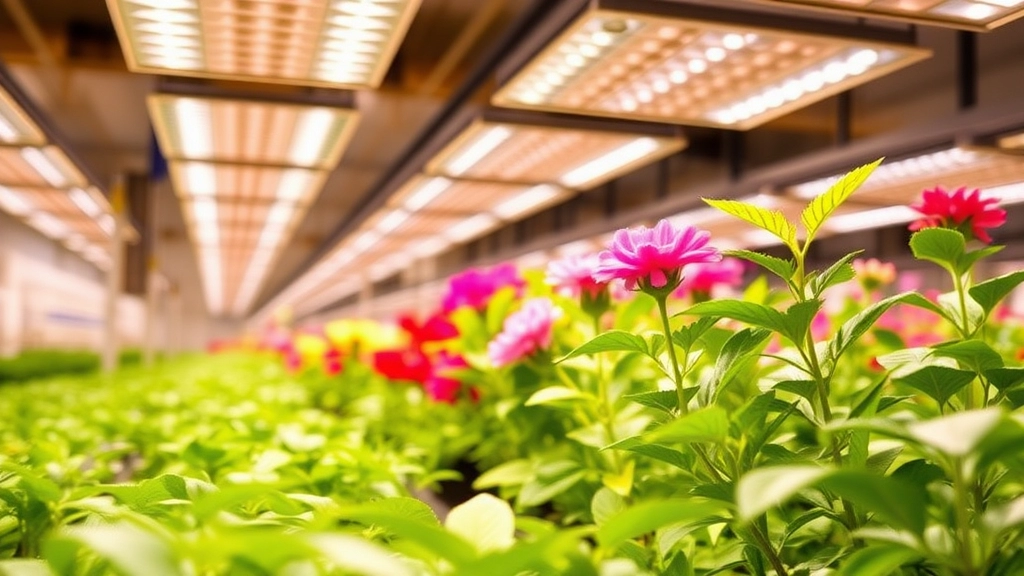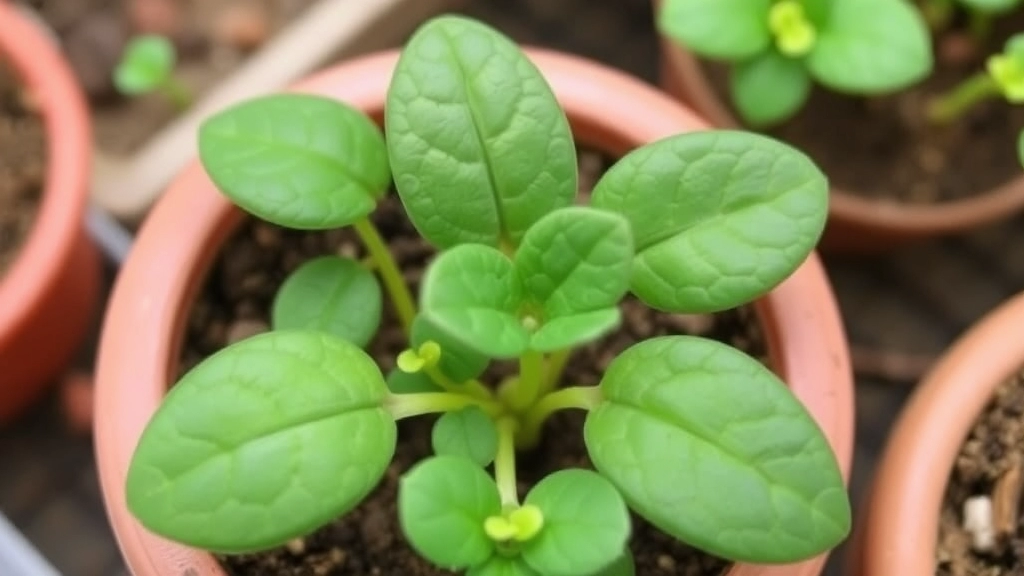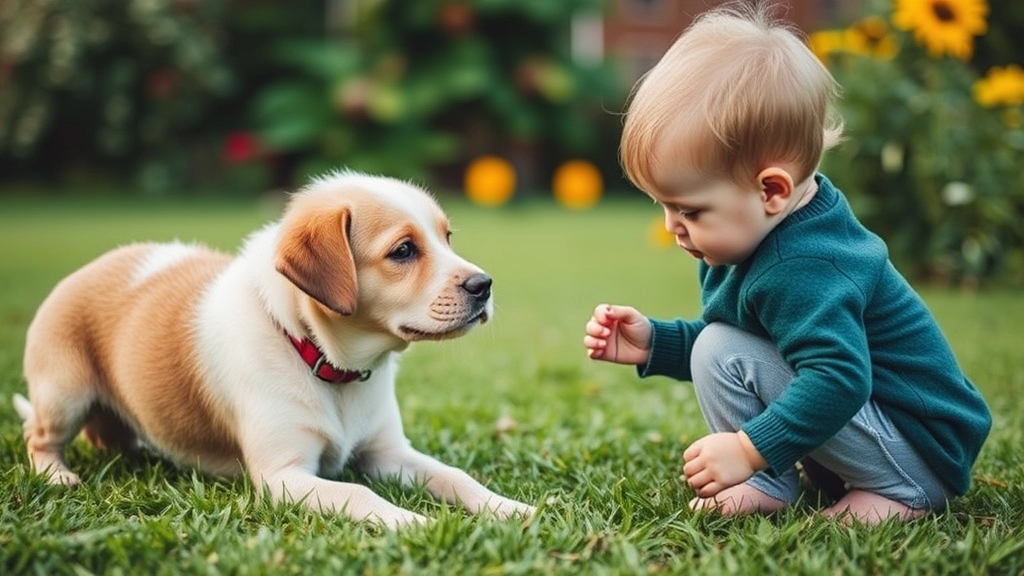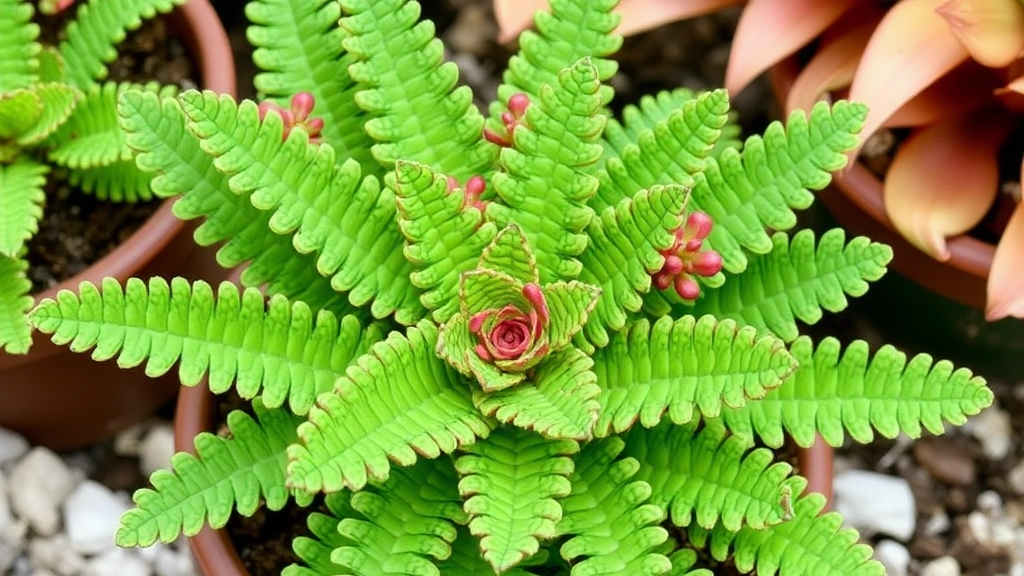Alligator Plant Kalanchoe Care Guide
When it comes to unique and easy-to-care-for succulents, the Alligator Plant Kalanchoe, also known as Kalanchoe daigremontiana, stands out. This fascinating plant, often called the Mother of Thousands, is perfect for those looking to add an interesting touch to their indoor or outdoor garden. In this guide, I’ll share essential tips on how to care for your Alligator Plant, ensuring it thrives and remains a stunning focal point in your space.
Light and Environment
First off, the Alligator Plant Kalanchoe thrives in bright, indirect light and prefers a warm environment. Ensure you use well-draining soil and avoid overwatering to prevent root rot.
Propagation
One of the most exciting aspects of this plant is its ability to propagate through leaf plantlets, making it incredibly easy to grow new plants. However, be mindful of its toxicity to pets and children.
With the right care and attention, your Alligator Plant will flourish, adding a unique charm to your home.
How to Care for the Alligator Plant (*Kalanchoe daigremontiana*)
Many plant enthusiasts often wonder how to keep their Alligator Plant thriving.
This unique succulent, known for its distinctive leaf shape and ease of care, can be a rewarding addition to your indoor garden.
Understanding Your Alligator Plant
Caring for the Alligator Plant involves understanding its specific needs.
- Light: Alligator Plants thrive in bright, indirect sunlight.
- Temperature: They prefer warmer conditions, ideally between 20°C to 30°C.
By ensuring your plant receives the right light and temperature, you’re setting it up for success.
Light and Temperature Requirements for Healthy Growth
Light and temperature play crucial roles in the health of your Alligator Plant.
- Optimal Light: Place your plant near a window where it can soak up bright, indirect sunlight for several hours each day.
- Avoid Direct Sun: Too much direct sunlight can scorch the leaves.
- Temperature Range: Keep your plant in a warm environment, avoiding temperatures below 10°C.
With the right light and temperature, your Alligator Plant will flourish beautifully.
Proper Soil and Watering Tips for Alligator Plants
Next, let’s discuss soil and watering, essential components for keeping your Alligator Plant healthy.
- Soil Type: Use well-draining soil, such as a cactus or succulent mix.
- Watering Frequency: Water when the top inch of the soil feels dry. This typically means every 2-3 weeks.
- Overwatering Caution: Be careful not to let your plant sit in water, as this can lead to root rot.
When you master soil and watering, your Alligator Plant will thrive.
Easy Propagation Methods: Growing New Plants from Plantlets
One of the joys of caring for the Alligator Plant is its ability to propagate easily.
- Plantlets: These are small offsets that grow along the edges of the leaves.
- Propagation Steps:
- Gently remove a plantlet from the mother plant.
- Allow it to dry for a day to form a callus.
- Plant it in well-draining soil and water lightly.
This method not only expands your collection but also gives you the satisfaction of nurturing new growth.
Common Problems and Solutions for Alligator Plants
Even with the best care, you may encounter some issues with your Alligator Plant.
- Yellow Leaves: This could indicate overwatering. Adjust your watering schedule.
- Leggy Growth: If your plant becomes stretched, it may need more light.
- Pests: Check for mealybugs or aphids. A gentle wash with water can help remove them.
By identifying and addressing these common problems, you can keep your Alligator Plant healthy and vibrant.
Toxicity and Safety Concerns for Pets and Children
It’s important to be aware of the toxicity of the Alligator Plant.
- Toxicity: The plant is considered toxic if ingested.
- Precautions: Keep it out of reach of pets and small children to avoid accidental ingestion.
Being informed about safety concerns ensures a worry-free environment for your loved ones.
Seasonal Maintenance: Repotting, Pruning, and Dormancy
As seasons change, so do the needs of your Alligator Plant.
- Repotting: Consider repotting every couple of years to refresh the soil and provide room for growth.
- Pruning: Remove any dead or yellowing leaves to promote healthy growth.
- Dormancy: In winter, reduce watering as the plant enters a dormant phase.
By following these seasonal maintenance tips, you’ll ensure your Alligator Plant remains healthy year-round.
Light and Temperature Requirements for Healthy Growth

So, you’ve got your Alligator Plant (Kalanchoe daigremontiana) and you’re wondering what it needs to thrive.
First off, let’s talk about light.
Light Needs
- Bright, Indirect Sunlight: Your Alligator Plant loves the sun but not too much direct exposure. A south or east-facing window is ideal.
- Avoid Harsh Sunlight: Too much direct sunlight can scorch those lovely leaves. If you notice browning tips, it’s a sign to move it back a bit.
- Supplemental Lighting: If natural light is scarce, consider using grow lights. They can do wonders, especially during the dreary winter months.
Temperature Preferences
Now, onto temperature.
- Ideal Range: This plant prefers a cozy environment between 18°C to 24°C (65°F to 75°F).
- Avoid Cold Drafts: Keep it away from chilly windows or air conditioning vents. Sudden temperature drops can stress the plant.
- Winter Care: If you live in a colder climate, make sure your Alligator Plant doesn’t get exposed to temperatures below 10°C (50°F).
Proper Soil and Watering Tips for Alligator Plants
When it comes to nurturing your Alligator Plant (Kalanchoe daigremontiana), understanding its soil and watering needs is crucial for promoting healthy growth. You might be wondering, “What type of soil does my Alligator Plant need?” or “How often should I water it?” Let’s dive into these essential aspects.
Easy Propagation Methods: Growing New Plants from Plantlets

If you’ve been captivated by your Alligator Plant (Kalanchoe daigremontiana), you might be wondering how to multiply its beauty. Fortunately, this plant is known for its easy propagation through plantlets, making it a delightful endeavour for both novice and experienced gardeners.
Understanding Plantlets
The Alligator Plant produces small offsets, or plantlets, along the edges of its leaves. These plantlets are essentially miniature versions of the parent plant and can be easily rooted to create new plants.
Steps for Propagation
Here’s a straightforward guide to propagate your Alligator Plant:
- Select Healthy Plantlets
Look for well-developed plantlets on the leaf margins. They should be firm and green, indicating they are ready for propagation. - Gently Remove the Plantlet
Using clean scissors or your fingers, carefully detach the plantlet from the parent leaf. Ensure you don’t damage the main plant. - Allow to Callous
Place the detached plantlet in a dry, shaded area for a few hours or overnight. This allows the cut end to callous over, reducing the risk of rot when planted. - Prepare the Soil
Use a well-draining soil mix. A combination of cactus mix and perlite works well to ensure proper drainage. - Plant the Offset
Create a small hole in the soil, insert the calloused end of the plantlet, and gently press the soil around it. Ensure it stands upright. - Water Sparingly
Lightly mist the soil to moisten it, but avoid soaking. Overwatering can lead to rot. - Provide Optimal Conditions
Place the newly potted plantlet in a warm, bright location with indirect sunlight. This encourages healthy growth. - Monitor Growth
After a few weeks, you should see new growth. At this point, you can gradually increase watering as the plant establishes itself.
Propagation can be a rewarding experience, allowing you to share your Alligator Plant with friends or expand your collection. With a little patience and care, you’ll soon have a thriving array of new plants.
Common Problems and Solutions for Alligator Plants
As we delve into the common issues faced by Alligator Plant (Kalanchoe daigremontiana) enthusiasts, it’s essential to understand that even the hardiest plants can encounter challenges. Recognising these problems early can help ensure your plant thrives.
Leaf Dropping
One of the most frequent concerns is leaf dropping.
- Causes: Overwatering or sudden temperature changes are often to blame.
- Solution:
- Check the soil moisture; it should be dry before you water again.
- Maintain a stable temperature, ideally between 20-25°C.
Leaf Yellowing
Yellowing leaves can indicate several problems.
- Causes: Nutrient deficiency or insufficient light.
- Solution:
- Ensure your plant receives bright, indirect light.
- Consider a balanced fertiliser during the growing season.
Pests
Pests such as mealybugs and aphids can invade your Alligator Plant.
- Signs: Sticky residue or visible insects on the leaves.
- Solution:
- Wipe leaves with a damp cloth or use insecticidal soap.
- Regularly inspect your plant to catch infestations early.
Root Rot
Root rot is a serious issue that can arise from overwatering.
- Signs: Wilting despite wet soil or a foul smell from the pot.
- Solution:
- Remove the plant from its pot and inspect the roots.
- Trim away any rotten sections and repot in fresh, well-draining soil. For more detailed steps, check out our expert tips for healthy growth.
If you’re dealing with persistent issues, you might also want to explore our guide on how to care for a Kalanchoe succulent for more comprehensive care tips.
Toxicity and Safety Concerns for Pets and Children

You might be wondering, “Is my Alligator Plant safe around my pets and kids?”
Well, let’s dive into that.
The Alligator Plant (Kalanchoe daigremontiana) is a beautiful succulent, but it comes with some important safety notes.
Toxicity Levels
- Mildly Toxic: This plant contains compounds that can be harmful if ingested.
- Common Symptoms: If a pet or child munches on it, they might experience nausea, vomiting, or diarrhea.
Precautions to Take
- Placement: Keep your Alligator Plant out of reach of curious little hands and paws.
- Education: Teach kids about which plants are off-limits.
- Pet Supervision: If you have pets that love to nibble on greenery, consider placing this plant in a high spot or a room they can’t access.
What to Do If Ingested
- Stay Calm: If you suspect ingestion, don’t panic.
- Contact a Professional: Reach out to your vet or a poison control centre for guidance.
Seasonal Maintenance: Repotting, Pruning, and Dormancy
As we delve into the seasonal maintenance of the Alligator Plant, it’s essential to understand how these practices can enhance its growth and overall health. Many plant enthusiasts often wonder when and how to repot, prune, and manage dormancy for their beloved Kalanchoe daigremontiana.
Repotting Your Alligator Plant
Repotting is crucial for maintaining the health of your Alligator Plant. Here’s when and how to do it:
- When to Repot:
- Ideally, repot every 2-3 years or when you notice roots emerging from the drainage holes.
- Spring is the best time, as it aligns with the plant’s active growth phase.
- How to Repot:
- Choose a pot that is one size larger, ensuring it has good drainage.
- Use a well-draining soil mix, such as a cactus or succulent mix.
- Gently remove the plant from its old pot, loosening the roots if necessary, and place it in the new pot.
Pruning for Health and Aesthetics
Pruning not only keeps your Alligator Plant looking tidy but also encourages healthy growth. Here’s how to approach it:
- When to Prune:
- Prune in early spring before new growth begins.
- How to Prune:
- Remove any dead or yellowing leaves to promote airflow.
- Trim back leggy growth to encourage a bushier appearance.
- Use clean, sharp scissors to avoid damaging the plant.
Managing Dormancy
Understanding dormancy is vital for the Alligator Plant’s care. During this period, the plant conserves energy, and its growth slows down.
FAQs on Alligator Plant (Kalanchoe daigremontiana)
What kind of light does the Alligator Plant need?
The Alligator Plant thrives in bright, indirect sunlight. A south or east-facing window is ideal. Avoid harsh sunlight as it can scorch the leaves.
Can I use supplemental lighting for my Alligator Plant?
Yes, if natural light is scarce, you can use grow lights. They are especially useful during the winter months.
What is the ideal temperature range for the Alligator Plant?
The plant prefers temperatures between 18°C to 24°C (65°F to 75°F). Avoid exposing it to temperatures below 10°C (50°F).
How can I propagate my Alligator Plant?
You can propagate your Alligator Plant using the plantlets that grow along the edges of its leaves. Follow these steps: select healthy plantlets, gently remove them, allow them to callous, prepare well-draining soil, plant the offsets, water sparingly, and provide optimal conditions.
Is the Alligator Plant toxic to pets and children?
Yes, the Alligator Plant is mildly toxic. If ingested, it can cause nausea, vomiting, or diarrhea. Keep it out of reach of pets and children.
What should I do if my pet or child ingests the Alligator Plant?
If ingestion occurs, stay calm and contact a professional, such as a vet or a poison control center, for guidance.
How often should I water my Alligator Plant?
Water the plant sparingly. Overwatering can lead to root rot. Lightly mist the soil to moisten it, but avoid soaking.
What are the signs that my Alligator Plant is getting too much sunlight?
If you notice browning tips on the leaves, it’s a sign that the plant is getting too much direct sunlight. Move it to a spot with indirect light.
How do I ensure my Alligator Plant stays healthy during winter?
During winter, make sure the plant is not exposed to temperatures below 10°C (50°F). Using grow lights can help if natural light is insufficient.
References
-
How to Grow and Care for Alligator Plant Indoors
-
Alligator Plant Care: Tips For Growing Kalanchoe Daigremontiana
-
ASPCA: Toxic and Non-Toxic Plants – Alligator Plant
